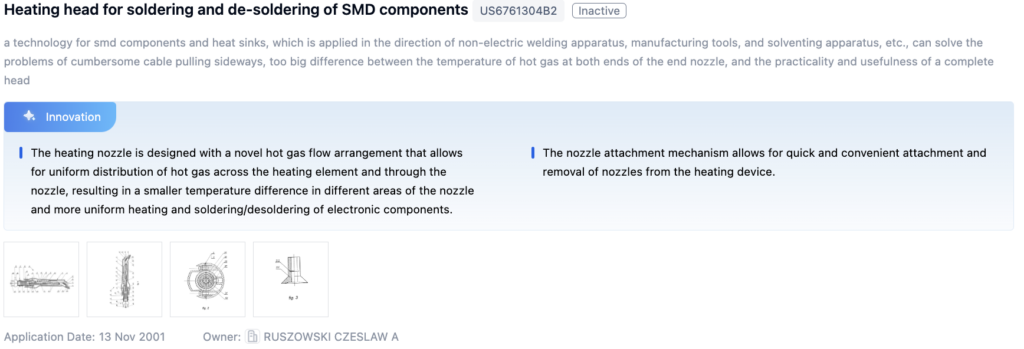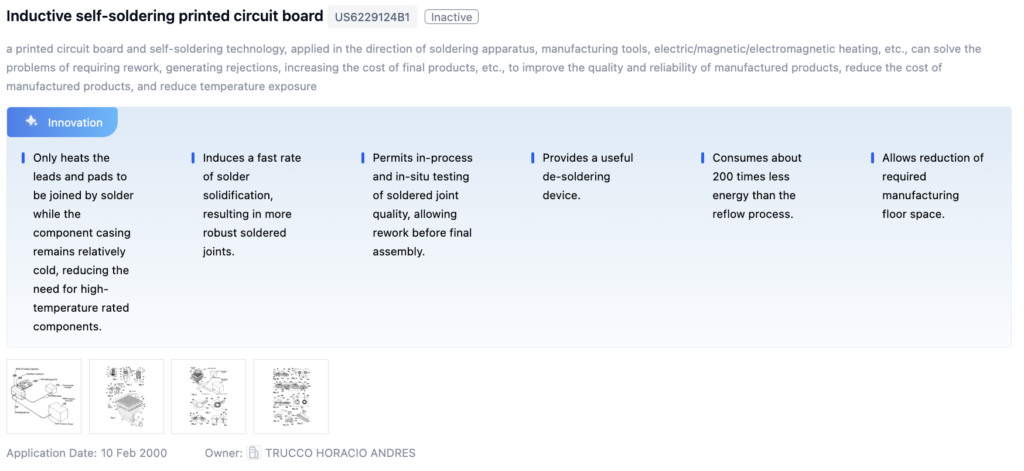
Technical Background and Objectives
Background
The field of ‘accelerating soldering’ under the broader category of ‘soldering’ has seen a steady increase in patent filings, indicating growing interest and research efforts. Patent applications have increased year by year, peaking before a gradual decline. This trend suggests a surge in commercial interest and innovation efforts aimed at developing fast soldering technologies. In contrast, the number of research publications has remained relatively stable, with slight fluctuations, indicating a consistent level of academic interest. This divergence suggests that commercial and industrial applications primarily drive innovations in fast soldering.

Objectives
The primary objective is to develop innovative techniques and methodologies for accelerating the soldering process while maintaining high quality and reliability. This research focuses on exploring new materials, processes, and technologies that can facilitate faster soldering without compromising the integrity of the joints or introducing defects.
To get a detailed scientific explanations of Fast Soldering, try Eureka.
Technical Current Status Analysis
Soldering Overview
Soldering is crucial in industries like electronics manufacturing, aerospace, automotive, and telecommunications. It involves joining metal components by melting and applying a filler metal known as solder. The speed of soldering impacts productivity, efficiency, and overall manufacturing costs.
Applications and Impact:
- Electronics: Mass production of printed circuit boards (PCBs) and electronic components.
- Aerospace and Automotive: Assembly and repair of electrical systems, sensors, and control modules.
- Telecommunications: Installation and maintenance of communication networks, including fiber optic cables and copper wires.
Technical Characteristics and Challenges:
- Heat Transfer Efficiency: Rapid and uniform heat transfer is essential for fast soldering.
- Solder Alloy Properties: Melting point, wetting behavior, and fluidity significantly influence soldering speed and quality.
- Surface Preparation and Cleanliness: Critical for good wetting and strong metallurgical bonds.
- Process Control and Automation: Precise control over parameters like temperature and flux application is essential.
- Thermal Management: Rapid heating and cooling cycles can cause thermal stresses and potential damage.
- Flux and Residue Management: Proper selection and application of flux, as well as effective residue removal, are important.
- Operator Skill and Training: Skilled operators are essential for manual soldering tasks and process monitoring.
Technological Paths:
- Advanced Heat Sources: High-efficiency heat sources like laser soldering and induction heating.
- Solder Alloy Development: New compositions with lower melting points and improved wetting behavior.
- Surface Treatment and Cleaning Technologies: Advanced methods like plasma cleaning to improve surface wettability.
- Process Automation and Robotics: Implementing automation for precise control over soldering parameters.
- Thermal Management Solutions: Advanced heat sinks and cooling techniques to manage thermal stresses.
- Flux and Residue Management Systems: Efficient flux application and residue removal methods.
- Operator Training and Skill Development: Comprehensive training programs for operators.

Research Content
Research Objectives
Develop innovative techniques and methodologies for accelerating the soldering process while maintaining high quality and reliability standards.
Research Direction and Focus
Materials and Alloy Development
- Develop advanced soldering materials and alloys with superior thermal properties and wettability.
- Investigate new alloy compositions and nanoparticle-enhanced solders.
Process Optimization and Automation
- Optimize soldering processes using ultrasonic-assisted, laser, or induction heating.
- Integrate automation and robotics to streamline workflows and improve consistency.
Thermal Management and Heat Transfer
- Investigate innovative heat transfer mechanisms, such as advanced heat sinks and phase-change materials.
- Use CFD simulations and experimental studies to analyze and optimize heat transfer pathways.
Quality Control and Reliability Testing
- Incorporate rigorous quality control measures, including non-destructive testing techniques like X-ray inspection and ultrasonic testing.
- Perform accelerated aging tests and environmental stress testing to assess long-term reliability.
Technical Development Roadmap
Key Areas of Advancement
- Advanced Soldering Materials: Development of lead-free solder alloys, low-temperature soldering materials, and conductive adhesive soldering materials.
- Soldering Process Automation and Control: Automated optical inspection (AOI) systems, closed-loop process control systems, and intelligent defect detection and repair technologies.
- Soldering Equipment and Tooling: Innovations like vapor phase soldering systems, laser soldering systems, and selective soldering systems.

Main Player Analysis
Key Players and Focus
- Siemens AG: 1292 patents focused on integrating advanced soldering methodologies into industrial automation and manufacturing solutions.
- Daiichi Shokai Co. Ltd.: 3520 patents focused on developing innovative soldering solutions, optimizing solder alloy compositions, flux formulations, and process parameters.
- Dalian University of Technology: 39 publications focused on fundamental aspects like material science and metallurgy.
- Intel Corp.: 1237 patents driven by the need for reliable soldering solutions in semiconductor manufacturing.
- Georgia Institute of Technology: 33 publications focused on microstructural analysis and intermetallic compound formation.
Current Technical Solution Overview
Fast Soldering Techniques
- Low-Temperature Solder Pastes and Creams: Facilitating faster soldering processes.
- Optimized Solder Wave Configurations: Improving soldering efficiency in wave soldering processes.
- Pre-Fluxed Solder Powders and Foils: Simplifying the soldering process and reducing preparation time.
- Specialized Soldering Techniques: Tailored for specific applications like soldering electronic components or through-hole soldering.
- Automated and Optimized Soldering Systems: Incorporating advanced features for increased soldering speed and efficiency.
Automatic Soldering Machines and Processes
- Machines with Fast Soldering Capabilities: Designed for quick and efficient soldering operations.
- Precise Soldering Control: Offering precise control over soldering parameters.
- Specialized Soldering Techniques: Employing techniques like laser soldering and vacuum soldering.
- Integrated Soldering and Assembly Processes: Combining soldering operations with other assembly processes.
Soldering Fluxes and Pastes
- Flux Compositions and Formulations: Designed to facilitate soldering by removing oxides and promoting wetting.
- Solder Paste Compositions: Efficient for surface mount technology and other soldering processes.
- Flux-Cored Solders: Providing a consistent supply of flux during the soldering process.
- Lead-Free and Halogen-Free Materials: Environmentally friendly alternatives to traditional soldering materials.
Soldering Methods for Specific Applications
- Using Solder Paste or Cream Solder: Faster soldering and better control over solder application.
- Pre-Fluxed or Coated Solder: Eliminating the need for separate flux application.
- Wave Soldering Methods: Optimized for faster soldering.
- Selective Soldering Methods: Applying solder to specific areas.
- Reflow Soldering Methods: Optimized for faster heating and cooling.
Soldering Iron Designs and Control Systems
- Integrated Solder Feeding Mechanisms: Automatically feeding solder for faster operations.
- Temperature Control Systems: Maintaining precise and consistent tip temperatures.
- Integrated Solder Suction or Desoldering Capabilities: Efficient removal of solder during rework or repair.
- Ergonomic and User-Friendly Designs: Improving operator comfort and efficiency.
- Specialized Tip Designs: Tailored for specific soldering applications.
Key Patent Interpretation
Patent Highlights
Patent 1: Auxiliary Device for Tin Soldering for Circuit Board
- Core Invention Points:
- Integrates a moving device and adjustment device for soldering on all four sides of the circuit board.
- Includes a deodorizing device to remove irritating odors during soldering.

Patent 2: Heating Head for Soldering and De-Soldering of SMD Components
- Core Invention Points:
- Novel hot gas flow arrangement for uniform heating.
- Quick and convenient nozzle attachment mechanism.

Patent 3: Inductive Self-Soldering Printed Circuit Board
- Core Invention Points:
- Only heats the leads and pads to be joined by solder.
- Induces a fast rate of solder solidification.
- Permits in-process testing of soldered joint quality.

Possible Research Directions
- Fast Soldering Techniques Using Induction Heating: Precise and localized heating for rapid soldering.
- Automated Soldering Systems for High-Speed Soldering: Automated systems for faster and more efficient soldering.
- Soldering Methods and Fluxes for Rapid Wetting and Bonding: Techniques to reduce soldering time.
- Soldering Iron Temperature Control for Fast Soldering: Advanced temperature control systems for quick operations.
- Specialized Soldering Jigs and Fixtures: Devices to hold components in place and facilitate rapid soldering.
If you want an in-depth research or a technical report, you can always get what you want in Eureka Technical Research. Try now!

